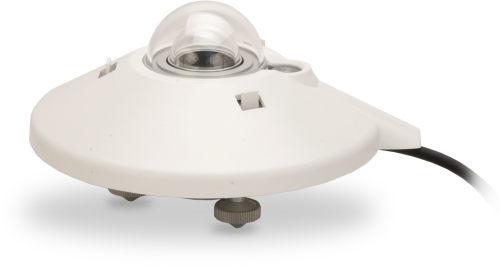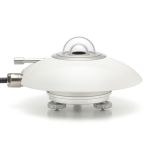
Overview
The CMP10, manufactured by Kipp & Zonen, is an ISO Class A (secondary standard) pyranometer that monitors solar radiation for the full solar spectrum range. It connects directly to a Campbell Scientific data logger and is well-suited for meteorological networks and solar-energy research and development.
Read MoreBenefits and Features
- Detector design and faster response make it a step above the CMP6
- Compatible with most Campbell Scientific data loggers
- Integrated bubble level is visible without removing sun shield
- Internal drying cartridge prevents dew from forming on the inner sides of the domes
- Compatible with the CVF4 heater/ventilator that keeps the domes free from ice and dew
- Measures reflected solar radiation when inverted
- Provides measurements in direct sunlight, under plant canopies, when the sky is cloudy, and in artificial light
Images








Detailed Description
The CMP10 measures solar radiation with a high-quality blackened thermopile protected by two glass domes. Its flat spectral sensitivity, from 285 to 2800 nm, makes it ideal for applications in natural sunlight, under plant canopies, in greenhouses or buildings, and inverted to measure reflected solar radiation.
An internal drying cartridge prevents dew from forming on the inner sides of the CMP10's domes. Campbell Scientific also offers the CVF4 heater/ventilator that keeps its domes free from ice and dew.
The CMP10 includes a white snap-on sun shield that reduces the sensor's temperature. A bubble level and adjusting leveling screws enable the sensor to be leveled without using a leveling base.
The CMP10 produces a millivolt signal that is measured directly by a Campbell Scientific data logger.
Specifications
| Sensor | High-quality blackened thermopile protected by two glass domes |
| Measurement Description | Monitors solar radiation for the full solar spectrum range |
| ISO Classification | Class A (secondary standard) |
| Spectral Range | 285 to 2800 nm |
| Sensitivity | 7 to 14 µV/W/m2 |
| Temperature Dependence of Sensitivity | < 1% (-10° to +40°C) |
| Response Time | < 5 s (95% of final value) |
| Zero Offset Due to Thermal Radiation | < 7 W/m2 (200 W/m2) |
| Non-Stability | < 0.5% (change/year) |
| Non-Linearity | < 0.2% (0 to 1000 W/m2) |
| Directional Error | < 10 W/m2 (up to 80° with 1000 W/m2 beam) |
| Tilt Error | < 0.2% |
| Level Accuracy | 0.1° |
| Impedance | 10 to 100 Ω |
| Operating Temperature Range | -40° to +80°C |
| Typical Signal Output | 0 to 15 mV (for atmospheric applications) |
| Maximum Irradiance | 4000 W/m2 |
| Expected Daily Uncertainty | < 2% |
| Dome Diameter | 5 cm (2 in.) |
| Width | 15 cm (5.9 in.) with shield |
| Height | 9.25 cm (3.64 in.) |
| Weight | 0.9 kg (2 lb) with 10.1 m (33 ft) cable |
Compatibility
Note: The following shows notable compatibility information. It is not a comprehensive list of all compatible or incompatible products.
Data Loggers
| Product | Compatible | Note |
|---|---|---|
| CR1000 (retired) | ||
| CR1000X (retired) | ||
| CR300 (retired) | ||
| CR3000 (retired) | ||
| CR310 | ||
| CR350 | ||
| CR6 | ||
| CR800 (retired) | ||
| CR850 (retired) |
Additional Compatibility Information
Mounting
The CMP10 has a bubble level and two leveling feet, which allow it to be leveled without using a leveling base. This pyranometer mounts to a mast, crossarm, or pole (1.0 in. to 2.1 in. OD) via the CM255 or CM255LS mounting stand. The CMP10 should be mounted away from all obstructions and reflective surfaces that might adversely affect the measurement.
Frequently Asked Questions
Number of FAQs related to CMP10-L: 5
Expand AllCollapse All
-
Most Campbell Scientific sensors are available as an –L, which indicates a user-specified cable length. If a sensor is listed as an –LX model (where “X” is some other character), that sensor’s cable has a user-specified length, but it terminates with a specific connector for a unique system:
- An –LC model has a user-specified cable length for connection to an ET107, CS110, or retired Metdata1.
- An –LQ model has a user-specified cable length for connection to a RAWS-P weather station.
If a sensor does not have an –L or other –LX designation after the main model number, the sensor has a set cable length. The cable length is listed at the end of the Description field in the product’s Ordering information. For example, the 034B-ET model has a description of “Met One Wind Set for ET Station, 67 inch Cable.” Products with a set cable length terminate, as a default, with pigtails.
If a cable terminates with a special connector for a unique system, the end of the model number designates which system. For example, the 034B-ET model designates the sensor as a 034B for an ET107 system.
- –ET models terminate with the connector for an ET107 weather station.
- –ETM models terminate with the connector for an ET107 weather station, but they also include a special system mounting, which is often convenient when purchasing a replacement part.
- –QD models terminate with the connector for a RAWS-F Quick Deployment Station.
- –PW models terminate with the connector for a PWENC or pre-wired system.
-
Not every sensor has different cable termination options. The options available for a particular sensor can be checked by looking in two places in the Ordering information area of the sensor product page:
- Model number
- Cable Termination Options list
If a sensor is offered in an –ET, –ETM, –LC, –LQ, or –QD version, that option’s availability is reflected in the sensor model number. For example, the 034B is offered as the 034B-ET, 034B-ETM, 034B-LC, 034B-LQ, and 034B-QD.
All of the other cable termination options, if available, are listed on the Ordering information area of the sensor product page under “Cable Termination Options.” For example, the 034B-L Wind Set is offered with the –CWS, –PT, and –PW options, as shown in the Ordering information area of the 034B-L product page.
Note: As newer products are added to our inventory, typically, we will list multiple cable termination options under a single sensor model rather than creating multiple model numbers. For example, the HC2S3-L has a –C cable termination option for connecting it to a CS110 instead of offering an HC2S3-LC model.
-
The ISO and WMO classify First Class pyranometers, such as the CMP6-L, as suitable for network operations. However, if accuracy is of paramount concern, consider using Class A pyranometers, such as the CMP11-L and CMP21-L, instead.
-
Because of the loss of IR radiation, nearly all thermopile instruments typically have a negative offset. This offset is most easily visible at night-time, when a small negative value is read instead of zero. This same offset is present during the daytime, but it is not as visible because of the large solar signal.
Another common issue involves leveling an instrument. Leveling a thermopile instrument can cause errors in the direct beam component because the cosine response is not correct. These errors are more notable when the sun is close to the horizon because the angle is so shallow.
-
Many Campbell Scientific sensors are available with different cable termination options. These options include the following:
- The –PT (–PT w/Tinned Wires) option is the default option and does not display on the product line as the other options do. The cable terminates in pigtails that connect directly to a data logger.
- In the –C (–C w/ET/CS110 Connector) option, the cable terminates in a connector that attaches to a CS110 Electric Field Meter or an ET-series weather station.
- In the –CWS (–CWS w/CWS900 Connector) option, the cable terminates in a connector that attaches to a CWS900-series interface. Connection to a CWS900-series interface allows the sensor to be used in a wireless sensor network.
- In the –PW (–PW w/Pre-Wire Connector) option, the cable terminates in a connector that attaches to a prewired enclosure.
- In the –RQ (–RQ w/RAWS Connector) option, the cable terminates in a connector that attaches to a RAWS-P Permanent Remote Automated Weather Station.
Note: The availability of cable termination options varies by sensor. For example, sensors may have none, two, or several options to choose from. If a desired option is not listed for a specific sensor, contact Campbell Scientific for assistance.
Privacy Policy Update
We've updated our privacy policy. Learn More
Cookie Consent
Update your cookie preferences. Update Cookie Preferences

